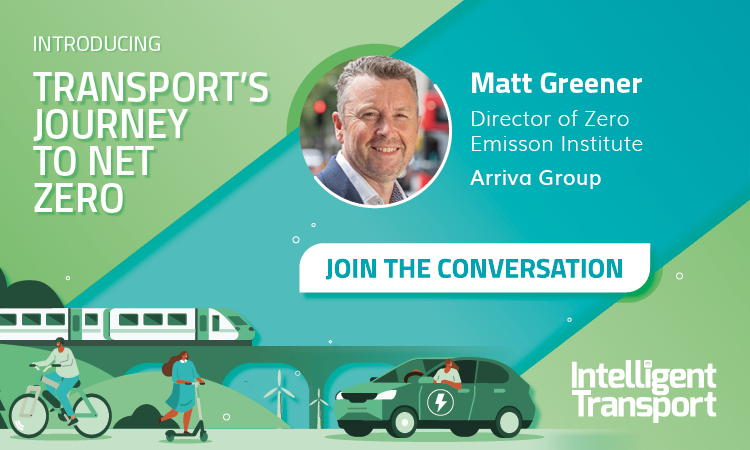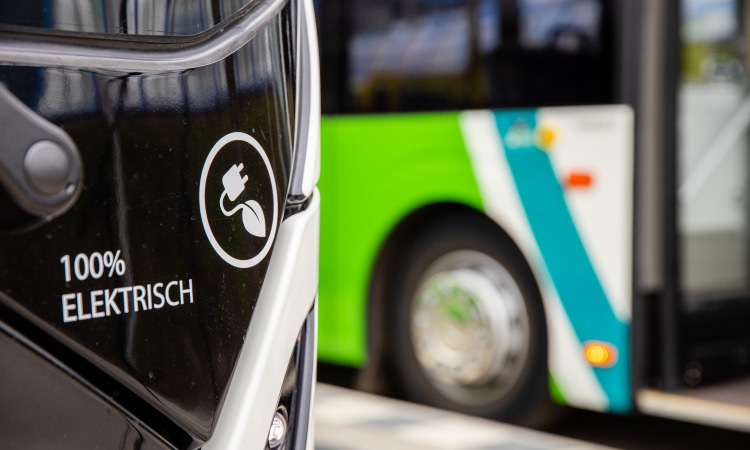Transport’s journey to net zero: Modal shift is the key to decongesting our cities, says Arriva
- Like
- Digg
- Del
- Tumblr
- VKontakte
- Buffer
- Love This
- Odnoklassniki
- Meneame
- Blogger
- Amazon
- Yahoo Mail
- Gmail
- AOL
- Newsvine
- HackerNews
- Evernote
- MySpace
- Mail.ru
- Viadeo
- Line
- Comments
- Yummly
- SMS
- Viber
- Telegram
- Subscribe
- Skype
- Facebook Messenger
- Kakao
- LiveJournal
- Yammer
- Edgar
- Fintel
- Mix
- Instapaper
- Copy Link
Posted: 31 August 2022 | Matt Greener - Arriva Group | No comments yet
For the first instalment of Intelligent Transport’s exclusive sustainable transport Q&A series, Matt Greener, Director of Arriva Group’s Zero Emission Institute, discusses the importance of collaboration between public transport authorities, operators and the wider industry to accelerate the zero-emission transition, as well as what more needs to be done by governments to encourage modal shift.


The ever-pressing challenges of poor air quality and traffic congestion have been a key focus for the transport industry as operators and authorities strive to achieve their net zero targets. How big a part does the decarbonisation of public transport play in reducing the UK’s carbon emissions?
Getting people out of private cars and onto public transport is one of the most impactful changes we can make, and it’s something that can be done right now”
When it comes to decarbonisation and, in particular, air quality – there are two priorities. The first, and by far the most important, is encouraging modal shift – getting people out of private cars and onto public transport is one of the most impactful changes that we can make, and it’s something that can be done right now. Arriva has an ambition to make public transport the best choice for people and, to achieve this, we need fast, reliable and interconnected transport systems, which requires commitment and planning between public transport authorities (PTAs) and operators.
The second priority is the decarbonisation of the public transport sector, which is underway to some extent, but I admit it is complex and requires the long-term planning of infrastructure, including green energy supplies. This is why Arriva has set up its Zero Emission Institute (ZEI) as a central hub of knowledge and expertise, working with the industry to try and make the transition easier, cheaper and more practical.
Our ZEI draws on expertise from parts of our network which are advanced on their zero-emission journey, like The Netherlands which will be net zero by 2025 and uses its learnings to work with other parts of our network which are less experienced. Partnership is critical and I don’t just mean between PTA’s and operators – I mean with the wider industry, with academic institutions, with industrial designers and manufacturers, with town planners and of course, with green energy suppliers. We must work together to create the right environment for the zero-emission transition – it’s not something that Arriva can achieve alone.
What are the immediate challenges that Arriva Group is facing in decarbonising its public transport fleet?
There are big challenges, particularly when it comes to capital investment because the cost of a zero-emission vehicle is twice that of a diesel bus. Across Europe we have a fleet of 14,500 vehicles, so this is a big consideration”
There are big challenges, particularly when it comes to capital investment because the cost of a zero-emission vehicle is twice that of a diesel bus. Across Europe we have a fleet of 14,500 vehicles, so this is a big consideration. We need to work with vehicle designers and manufacturers and with the whole supply chain to bring down the unit cost of zero-emission buses. We also need to work with PTAs to facilitate longer term contracts and be decisive about which technology they want to adopt for the long term – this will improve the life-cycle costs of the vehicles and it will also provide operators with economies of scale and give us the flexibility to move assets between regions and optimise our fleet, dependent on local demand.
The other big issue is grid capacity. We can’t simply transition a huge fleet without knowing we have the right green energy supply in place, and this can be a postcode lottery as grid capacity could be limited. Therefore, planning grid upgrades with the energy distribution network operators (DNO) to get the power where it is needed can take a few years. This can be particularly challenging in major towns and cities, as we experienced with our recently electrified London Brixton depot where the DNO was required to lay new underground cabling across busy main roads and other public access areas, which required major construction and planning.


Credit: Arriva Group
What projects does Arriva Group currently have in the pipeline that will help to achieve a more sustainable transport system in the UK and more globally?
The work Arriva has done in The Netherlands is the best example of how to transition to zero-emission vehicles. We have committed to being carbon neutral by 2025, so we are very advanced on our journey in that market. Partnership with local transport authorities has been crucial in achieving this as well, as strong central government legislation that dictates all buses from 2030 have to be zero-emission, thus allowing Arriva to make long-term strategic investments.
In Madrid, we have recently built a new head office and depot which… has a rainwater capture scheme to enable washing of vehicles without tapping into fresh water supplies”
In other parts of Europe, we have a lot of projects underway too. For example, in Madrid, we have recently built a new head office and depot which has been designed with low carbon principles. Not only is the depot equipped with electric vehicle charging infrastructure, it also generates solar power and has a rainwater capture scheme to enable washing of vehicles without tapping into fresh water supplies.
Furthermore, in the UK we have recently introduced a hybrid train into operations. Called the HybridFlex, the train started operating passenger services out of London Marylebone Station in July 2021. It’s the UK’s very first 100 mph battery-diesel hybrid train, and has been developed in partnership with Rolls-Royce and Porterbrook. The hybrid train allows retrofitting of an existing diesel train, so it can switch to electric when entering and leaving a station – thereby reducing noise and emissions, improving local air quality. From London-Birmingham simulations we have found that a Class 168 HybridFLEX unit adopting a fuel conservation driving strategy can deliver the following improvements:
- Reduce fuel consumption by 25 per cent
- CO2 emissions reduced by 122 tonnes per year
- Reduce noise by 75 per cent
- Reduce friction braking energy usage by 40 per cent
- Reduce nitrous oxide by 75 per cent
- Reduce particulate emissions by 90 per cent.


Credit: Arriva Group
Although public transport has seen a global increase in ridership post-pandemic, car use continues to be more resilient. What is being done to encourage modal shift from the private car, and how significant is improving active travel and public transport infrastructure in achieving this?
To incentivise modal shift, partnership between operators and transport authorities is key. Passengers want frequent, reliable public transport options, which means governments need to invest in prioritising public transport”
Modal shift is one of the most impactful things we can all do to reduce carbon emissions, while also improving air quality and decongesting our towns and cities. It is essential if we are to achieve our climate goals and it’s also something that can be achieved right now. However, to incentivise modal shift, partnership between operators and transport authorities is key. Passengers want frequent, reliable public transport options, which means governments need to invest in prioritising public transport through bus lanes and other prioritisation initiatives. Currently, we’re seeing a lot of investment in public charging points for private electric vehicles – but this only encourages the purchase of electric cars and does nothing to encourage modal shift. An electric car traffic jam is still a traffic jam and causes delays on our roads, which in turn puts people off using bus services because they are seen as unreliable.
Modal shift is such a quick win, I’m constantly questioning the lack of government commitment. The development of MaaS solutions also encourages modal shift. In The Netherlands, we have developed a MaaS solution called Glimble, which is proving very successful. It allows passengers to plan, book and pay for interconnected public transport journeys, using all providers/operators nationwide and it also highlights the carbon saving that their choices provide. Glimble has been developed with pan-European potential so we can consider launching it in other countries in the future.
In an ideal world, what would a net zero transport system look like to you?
Arriva’s long-term vision is to help shape a future where passenger transport is considered the best choice”
Arriva’s long-term vision is to help shape a future where passenger transport is considered the best choice. We will do this by working in partnership with passenger transport authorities and municipalities across Europe to create sustainable transport solutions that cater for the way we live today, and tomorrow. We must design our services for a post-pandemic world, responding to the way our passengers want to travel. Our industry has a very real role to play in transforming our towns and cities and helping to address the climate crisis.
At Arriva, we want to see a future where people choose to leave their cars at home – a future with less congestion on our roads which encourages more use of public transport and active travel. Our legacy should be cleaner air for the next generation.


If you would like to take part in our ‘Transport’s journey to net zero’ series, or would like to nominate a colleague to take part, please email: Halimah Haque, Editorial Assistant, Intelligent Transport.
Related topics
Accessibility, Air Quality, Alternative Power, Fleet Management & Maintenance, Mobility Services, Passenger Experience, Public Transport, Sustainable Urban Transport
Related modes
Bus & Coach
Related cities
Madrid
Related countries
Spain, The Netherlands, United Kingdom
Related organisations
Arriva, Arriva Group
Related people
Matt Greener








